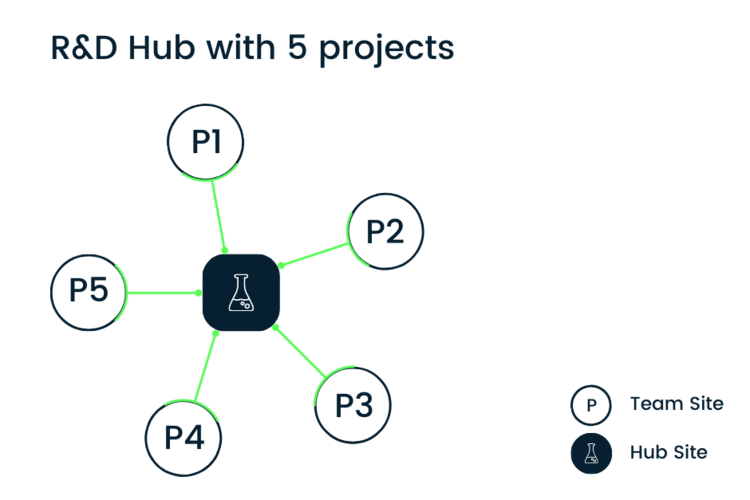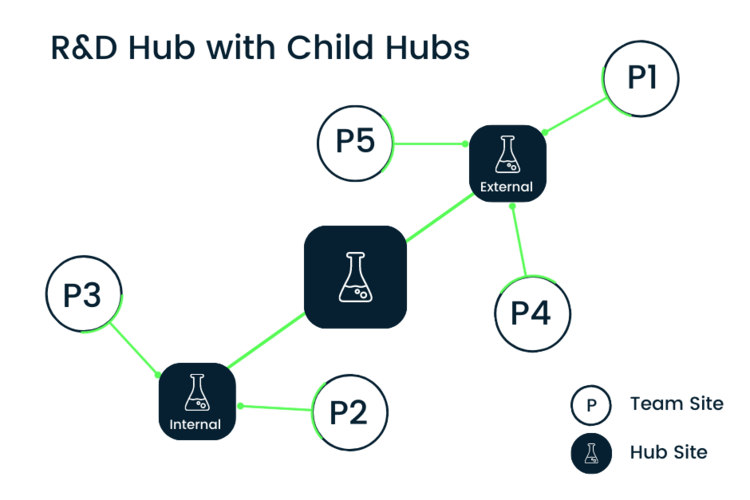Hub sites in SharePoint have been the way to go for a while now when it comes to implementing a structure for your intranet. When Microsoft first announced this feature at the Ignite 2017 conference it became clear that this would cause a massive paradigm shift for IT & SharePoint administrators worldwide. In this blogpost we’ll take a couple of minutes to take a closer look at what hubs are, where we came from and -of course- what are the advantages.
Subsites, a linear labyrinth for admins
You start off with a single SharePoint-site, your landings page. From there we add a sub site, followed by another sub site and another one, and so on. Before we know it, we’re ten levels deep spread over a hundred sites. The result is that the governance of a SharePoint-tenant becomes a daunting task for even the most seasoned administrator. What if, for example, a specific subsite had to be moved? The inheritance principle for access permissions makes this even more complex. When you automatically inherit permissions from the site above you quickly notice a need to break that inheritance to grant specific co-workers a specific set of rights for a specific site. Eventually you end up with a very granular set of permissions making things impossible to govern.
https://myawesomecompany.sharepoint.com/sites/Topsite/sub1/SubB/SubIII/...
A vertical structure with a bunch of sub sites also means that your URL-length grows very quickly. Now for browser-work this isn’t all too important, with a cap at 400 characters. But when you try syncing a library to you explorer with the OneDrive client you have to make sure you stay below 256 characters. Otherwise you’ll be greeted with a bunch of errors and a failure to do even the most basic of tasks in that library.
A new way of thinking
It is clear that a vertical structure is a direct consequence of the classic folder structure that has been in use for decennia worldwide. Folders in folders in folders, then… why not sites in sites in sites? A shift in mentality was needed to break this pattern. And during that Ignite-conference in 2017 Microsoft announced their game changer: hub sites.
The concept of hub sites is a grouping of specific sites and connecting the search experiences, the lay-out and navigation. SharePoint admins can group by whatever metric they want, but usually SharePoint admins group their sites by the business unit they belong to. Then we end up with a couple of hubs such as an HR-hub, a sales-hub, an R&D hub,… Let’s take this R&D hub as an example. We create a site called R&D and register it as a hub site. All our R&D-projects are managed in a specific team site per project which we connect to our R&D hub. What happens now is that all these sites will share a colour-theme, managed from the hub site. The search experiences are connected, meaning that you can look for documents in the entire hub rather than in either a single site or literally ever single site in your tenant. All of your sites will now share a customizable navigation bar as well. News and activities in the associated sites get promoted on the hub site as well, creating an overview of all the activities in the entire hub.

However, this doesn’t mean that we can forget about permissions. All of these sites keep their own set of permissions, meaning that an end user won’t automatically get access to every site in a hub after getting access to one. The hub owner has the option to enable the synchronization of permissions on the hub site, but it is up to the owner of every single associated site to allow that synchronization on their site. This feature is off by default.
A hub site can either be a team site or a communication site, the choice is up to you. However, what we see most often is that organizations tend to create portals for each business unit holding the information and resources relevant to that business unit, in that case a communication site might be your best option.
Sold! Now tell me how this works
Only SharePoint administrators can register a site as a hub site, this way the architecture and bigger picture part of the intranet is controlled by a select group of people. They can do this either via PowerShell or via the SharePoint admin center. Once a site is registered as a hub site, the SharePoint admin can choose who is allowed to associate sites to their hub site. Obviously, only the owner of a site can register a site to a hub.
Hub associations, sooo hubs inside of hubs then?
Since the end of 2021 hubs can now be associated with each other. In this case we take a hub and call it our parent hub. This hub can have sites associated just like a normal hub would. But it can also have child hubs associated to it, giving admins (of mostly larger organizations) an extra tool in their belt to organize and structure a company’s intranet. Not only the admins benefit from this, but end users do also. The search experience from the hubs are now connected as well, allowing for a richer search experience.





